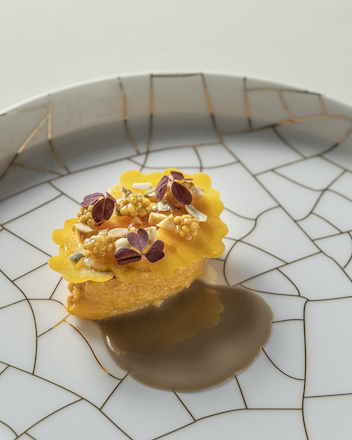According to science, pumpkins belong to the squash family, and, just like tomatoes, both pumpkins and squash are considered fruits! The very idea of a pumpkin tends to take people down the path of the large, round, bright-orange fruit to be carved into a jack-o'-lantern or magically transformed into Cinderella's carriage, but the fact is, any tough-skinned squash could technically be called a pumpkin.
With the onset of winter-themed menus amongst MICHELIN-listed restaurants in Singapore, pumpkin season has most definitely made its arrival known. Here are some of the popular varieties of pumpkin and squash and how they are served.
Japanese Pumpkin (Kabocha)
Naturally sweeter than butternut squash and whose taste is typically described to be a cross between a sweet potato and a pumpkin, the bright-yellow flesh of the kabocha is dense, and, when cooked, transforms into a rich and creamy consistency, making it ideal to use for pies, soups, stews, or even cookies. Make it a meal by roasting it with a knob of butter and consuming it as is.


Kabocha makes an appearance at two-MICHELIN-starred Saint Pierre's vegetarian menu, where it is prepared with almonds, mustard, and black truffles.
A pumpkin similar in flavour and texture as the kabocha is the Kent pumpkin, which can be found in one of the dishes at one-MICHELIN-starred Nouri. In a course called Scallop and Pumpkin, aged Kent pumpkin fondant is served alongside pan-seared Hokkaido scallop and pumpkin consommé.
(Photo: Saint Pierre's pumpkin dish)
Butternut Squash
Naturally sweet in flavour, butternut squash tends to be on the drier side in terms of texture when compared to the kabocha. Sharing the same versatility as the Japanese pumpkin, butternut squash contains a meaty flesh, which is both smooth and absent of thick, fibrous strands, making it an ideal component for sautéed dishes, roasts, and purées.
In MICHELIN-listed Preludio, butternut squash is prepared with chervil root, Comté cheese, confit egg yolk, and thyme, and is served as gnocchi in their executive lunch menu set.


Sugar Pumpkins
These smaller, bright-orange pumpkins get their namesake from their sugary sweet flavour. Typically served roasted and ideally the pumpkin of choice for baking pumpkin pies, sugar pumpkins are a common sight especially during Halloween. Once the festivities are over, they can also be baked, roasted, puréed, or stewed just like any other winter squash. Its small size makes it easier to handle in the kitchen, and its sweet, nutty flesh lends well to both savoury and sweet recipes.
Spaghetti Squash
A common low-carb alternative to the famous long-stranded pasta, spaghetti squash is often enjoyed with a splash of marinara. A trick of the trade when it comes to handling spaghetti squash involves cutting it in half, removing the seeds and pulp, and cooking it face-down on a baking dish. Once it becomes tender, grab a fork and gently drag it through the squash lengthwise. Strands of spaghetti squash will follow.

Turban Squash
Turban squash gets its name from its irregular shape. Coloured in a spectrum of mottled shades of green, orange, and yellow, the turban squash is known to be an heirloom variety, dating to the 1820s. Texture-wise, it is starchy and works extraordinary well in soups and stews. Its meaty flesh and subtle flavours also mean that it takes seasonings and spices quite beautifully.

Other MICHELIN restaurants that serve the humble pumpkin and squash on their menus are 1 Star Garibaldi along Purvis Street, where the Casoncelli di Zucca in the à la carte menu serves pumpkin stuffed in pasta and is served with Taleggio fondue and veal jus.
Combining an urban farm and dining concept, MICHELIN-listed Open Farm Community at the Singapore Botanic Gardens showcases pumpkin in a dish called Smashin' Pumpkin, where it is served with a variety of seeds, wild honey, and grainy mustard.
This article was adapted and updated from a previous version here.






















